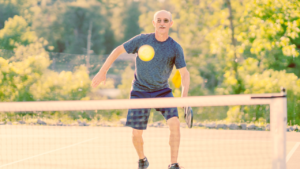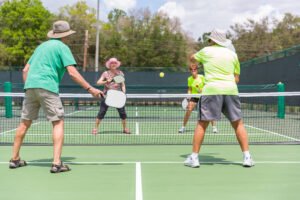Calling all pickleball enthusiasts! Have you ever found yourself court-side, feeling like everyone around you is speaking an entirely different language? Fear no more, for we bring you Pickleball Lingo 101: Talk the Talk While You Walk the Walk. Brace yourself for a thrilling journey into the vibrant world of this beloved sport’s unique jargon, as we decode the secret language behind every lob, dink, and kitchen violation. So, whether you are a seasoned player looking to expand your vocabulary or a curious beginner hoping to crack the code, get ready to dazzle your fellow players and talk the talk like a true pickleball pro!
Table of Contents
- What Does ”Dink” Mean and How to Master It?
- Unraveling the Mystery Behind “Third Shot Drop”
- Decoding the Art of “Stacking” in Pickleball Doubles
- The Ultimate Guide to Perfecting Your “Kitchen” Game
- Mastering the ”Erne” Shot: Tips and Techniques
- Q&A
- The Conclusion

What Does “Dink” Mean and How to Master It?
Have you ever heard the term “dink” and wondered what it could possibly mean? Well, fear not, because we’re here to demystify this unique word and guide you on how to master it!
So, what exactly does “dink” mean? In the realm of sports, specifically pickleball, it refers to a soft shot played close to the net, aimed to land just over the opponent’s reach. This delicate maneuver requires precision and finesse, making it an essential skill to have in your pickleball arsenal.
Now, let’s delve into how you can master the art of the dink:
- Footwork: Pay close attention to your footwork as you approach the net for a dink shot. Maintain a balanced stance and gently shuffle your feet to maintain stability and positioning.
- Grip: A firm yet relaxed grip is key to executing a successful dink shot. Your paddle should rest comfortably in your hand, allowing you to control the shot’s pace and direction.
- Touch: Developing a soft touch is crucial to perfecting the dink shot. Practice controlling the amount of power you put into the shot, ensuring that it lands softly over the net and just out of the opponent’s reach.
So, whether you’re a pickleball enthusiast looking to enhance your game or a beginner eager to learn the ins and outs, mastering the “dink” is a skill worth acquiring. Practice diligently, and soon enough, you’ll be dazzling your opponents with your impeccable dinking abilities!

Unraveling the Mystery Behind “Third Shot Drop”
The tennis technique known as the ”Third Shot Drop” has been revered by players and admired by spectators for its strategic brilliance on the court. This deceptive move involves hitting a soft, arcing shot after the return of serve in order to stifle the opponent’s momentum and gain control of the game. While it may seem like magic to some, understanding the intricacies behind this elusive maneuver can help players unlock its true potential.
Mastering the “Third Shot Drop” involves a combination of skillful shot placement, precise timing, and tactical awareness. By aiming the ball to land just beyond the kitchen or “no-volley” zone, players put their opponents in a tricky position, forcing them to either retreat to the back of the court or risk stepping inside the kitchen, where they are prohibited from volleying the ball. The objective is to create a difficult shot that gives the server and their partner ample time to advance towards the net and seize control of the game.
To execute the perfect “Third Shot Drop,” players must also pay attention to the ball’s trajectory and add a touch of spin to make it even more challenging for the opponent. By imparting a slight backspin and picking the right angle, the ball descends rapidly, making it harder to attack and increasing the chances of the recipient hitting a weaker return. Patience is key during this crucial shot, and players must resist the temptation to hit the ball too hard, sacrificing control for power. By maintaining composure and employing a softer touch, players can unravel the mystery behind the “Third Shot Drop” and harness its formidable potential on the tennis court.

Decoding the Art of “Stacking” in Pickleball Doubles
In the world of pickleball doubles, “stacking” is an advanced strategy that can elevate your game to new heights. This technique involves purposefully positioning yourself and your partner in a specific order, taking advantage of each player’s strengths to create a formidable force on the court.
So, how does stacking work? It starts with understanding your partner’s dominant hand. If both you and your partner are right-handed, one player will step back and assume the position on the left side of the court, while the other takes the dominant position on the right. This placement allows both partners to utilize their forehands, which are typically stronger and more reliable shots.
Once you’ve established the basic positioning, it’s time to dive deeper into the art of stacking. Here are a few key points to consider:
– Capitalize on court coverage: By stacking, you’ll have a better chance of covering the court efficiently, minimizing any gaps that opponents may exploit. With the stronger player in the dominant position, they can use their commanding reach to dominate the middle of the court, while the secondary player covers the cross-court shots.
– Strategic shot selection: Stacking also opens up a whole new world of shot options. With both players primarily utilizing their forehands, you can hit powerful cross-court shots, making it challenging for your opponents to return the ball effectively. This offensive approach keeps your opponents on their toes and puts pressure on them to adjust their game plan.
– Communication is key: Stacking requires seamless communication between partners. Keep the dialogue open and relay essential information about positioning and shot selection during each point. This ensures that both players are in sync and can make split-second decisions based on the ever-changing dynamics of the game.
In conclusion, mastering the art of stacking in pickleball doubles can give you a significant advantage on the court. Proper positioning, strategic shot selection, and effective communication are the pillars of this technique. So, next time you step onto the court with your partner, experiment with stacking and unlock a whole new level of gameplay.
The Ultimate Guide to Perfecting Your “Kitchen” Game
Whether you’re a seasoned chef or a novice cook just starting out, there’s always room to improve your “kitchen” game. From mastering basic knife skills to exploring exotic flavors, honing your culinary prowess can lead to countless delicious and satisfying meals. In this ultimate guide, we’ll take you on a journey through the essential techniques, tools, and ingredients that will help elevate your cooking to the next level.
Equip yourself with the right tools:
- A sharp chef’s knife: Invest in a high-quality chef’s knife and learn the proper way to hold and use it. A sharp knife not only makes slicing and dicing easier but also enhances your safety in the kitchen.
- A versatile cutting board: Look for a cutting board made of durable materials like bamboo or plastic with a groove to catch juices. Having multiple cutting boards for different food groups can prevent cross-contamination.
- Essential cookware: Build your kitchen arsenal with a reliable set of pots and pans. A non-stick skillet, a saucepan, and a stockpot are indispensable for a variety of dishes.
Master the fundamental techniques:
- Knife skills: Practice proper knife techniques such as chopping, mincing, and julienning. This will not only enhance your efficiency in the kitchen but also ensure even cooking and consistent texture in your dishes.
- Mise en place: Learning the art of “everything in its place” will save you time and stress during cooking. Prepare and organize your ingredients before you start cooking to streamline the process.
- Heat control: Understanding the power of heat and how to control it is vital for achieving perfect results. Familiarize yourself with cooking techniques like sautéing, roasting, baking, and simmering to harness the flavors of your ingredients.
Experiment with ingredients and flavors:
Don’t be afraid to get creative with ingredients and flavors to add excitement to your dishes. Try incorporating herbs and spices, experimenting with different combinations, and exploring multicultural cuisines. Pushing the boundaries of your culinary comfort zone will help you develop your own signature style in the kitchen.
Remember, perfecting your “kitchen” game is not just about creating stunning meals but also about enjoying the process and sharing your delicious creations with loved ones. With this ultimate guide, you’ll be well on your way to becoming a kitchen maestro!
Mastering the “Erne” Shot: Tips and Techniques
When it comes to pickleball, mastering the “Erne” shot can take your game to a whole new level. The Erne shot, named after its creator, Brian Erne, is a daring move that involves quickly moving to the non-volley zone (also known as the kitchen) while hitting the ball out of the air. It requires precision, timing, and a good understanding of the game. Here are some tips and techniques to help you become a master of the Erne shot:
- Footwork is key: To successfully execute the Erne shot, you need to have fast footwork. Practice shuffling quickly towards the kitchen line while keeping your balance. This will allow you to position yourself in the best spot for the shot.
- Stay low, stay ready: As you approach the non-volley zone, make sure to bend your knees and maintain a low, athletic stance. This will help you react quickly to the ball and maintain control during the shot.
- Timing is everything: The Erne shot requires impeccable timing. Anticipate your opponent’s shot and watch for opportunities to move towards the kitchen line. By timing your movement correctly, you can set yourself up for a successful Erne shot.
With practice and determination, you can master the Erne shot and add an impressive weapon to your pickleball arsenal. Remember to always stay focused, improve your footwork, and time your shots perfectly. Soon enough, you’ll be executing the Erne shot flawlessly, leaving your opponents in awe of your skills on the court.
Q&A
What is pickleball?
Pickleball is a popular paddle sport that combines elements of tennis, badminton, and table tennis. It is played on a smaller court with a solid paddle and a plastic ball.
Why is it called pickleball?
The origin of the name is shrouded in mystery. One popular theory suggests that the game was named after a dog called Pickles, who would chase after the ball and hide it in bushes during the early years of the sport.
What are the basic rules of pickleball?
Pickleball is played with two teams of two players each. The ball must be served underhand and diagonally across the net. The players can only enter the non-volley zone after the ball has bounced. The first team to reach 11 points, with a two-point lead, wins the game.
What does it mean when someone says “dink”?
In pickleball, a dink refers to a soft shot that is hit with precision, causing the ball to arc just over the net and drop into the opponent’s non-volley zone. It is often used as a strategy to control the pace of the game and force the opponent into a difficult position.
What does it mean when someone says “kitchen”?
The kitchen, also known as the non-volley zone, is a seven-foot area on each side of the net in pickleball. Players are not allowed to step into the kitchen to hit a volley unless the ball has bounced outside of this zone. It is an important strategic consideration during gameplay.
What is “third-shot drop”?
The third-shot drop is a shot in pickleball that is played during the start of a rally. It is typically hit softly, causing the ball to land in the opponent’s non-volley zone. This shot is employed to regain control of the game and set up a defensive position for your team.
What is a “side out” in pickleball?
A side out occurs when the serving team fails to win a point or commits a fault, resulting in the opposing team gaining the serve. It can happen if the ball lands out of bounds, fails to reach the net, or is hit in an incorrect manner. The term is also used to refer to when the receiving team successfully wins back the serve.
What does it mean to “stack” in pickleball?
In pickleball, stacking refers to a strategic positioning of players on the same side of the court. It is commonly used in doubles play, where players arrange themselves in a certain formation to maximize their court coverage and take advantage of their strengths.
What are “ernee” and “pickleballer”?
“Energee” is a term used to describe the energy and enthusiasm displayed by pickleball players. A “pickleballer” is a dedicated enthusiast of the sport who loves playing and promoting the game. These terms embody the passion that many pickleball players have for the sport.
The Conclusion
As we reach the end of our journey through the captivating world of Pickleball lingo, it’s time to step back and realize just how much we’ve learned. From dinks to slams, kitchen to Ernies, we’ve immersed ourselves in a language that is as dynamic as the sport itself.
Like seasoned players stepping onto the court, armed with their paddles and a strategic game plan, we too can now confidently venture into the Pickleball community armed with the knowledge of the game’s unique lexicon. No longer will we be caught off guard by a “pickle” reference or left puzzled by a ”henry.” We have assimilated the vocabulary, acquired an understanding, and can now fluently speak the language of the Paddle Sport Gods.
It’s not just about the words we’ve learned but the connections we’ve made. By mastering this lingo, we’ve gained access to a vibrant community of fellow enthusiasts who share our love for this addictive sport. Whether we engage in friendly banter on the sidelines or engage in heated game discussions, our newfound fluency in Pickleball lingo opens doors to friendships and camaraderie.
But let’s not forget the core lesson of our journey: Pickleball is not just another game; it’s a way of life. The intricacies of language reflect the intricacies of the game, with its fast-paced rallies, quick reflexes, and strategic finesse. As we walk the walk, we now have the power to speak the talk, adding another dimension of enjoyment and understanding to our Pickleball experiences.
Whether you’re a beginner or a seasoned pro, Pickleball lingo serves as the common thread that weaves us together, creating a vibrant community with a shared passion. So, go forth, fellow Pickleballers, and continue to learn and grow. Never hesitate to ask for clarification or delight in sharing your Pickleball knowledge with others.
Now armed with the secrets of dinks, bangers, and soft resets, let us approach each game with renewed enthusiasm and the understanding that we are now part of something greater. As we bid farewell, may your serves be strong, your volleys precise, and your love for Pickleball forever burn bright.
As an affiliate, my content may feature links to products I personally use and recommend. By taking action, like subscribing or making a purchase, you’ll be supporting my work and fueling my taco cravings at the same time. Win-win, right?
Want to read more? Check out our Affiliate Disclosure page.




